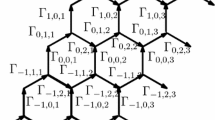Abstract
We consider the Schrödinger operator with a periodic potential on quasi-1D models of zigzag single-wall carbon nanotubes in magnetic field. The spectrum of this operator consists of an absolutely continuous part (intervals separated by gaps) plus an infinite number of eigenvalues with infinite multiplicity. We obtain identities and a priori estimates in terms of effective masses and gap lengths.
Similar content being viewed by others
References
Harris P. (1999). Carbon Nanotubes and Related Structures. Cambridge University Press, Cambridge
Kargaev P. and Korotyaev E. (1995). Effective masses and conformal mappings. Commun. Math. Phys. 169: 597–625
Kargaev P. and Korotyaev E. (1997). The inverse problem for the Hill operator, a direct approach. Invent. Math. 129: 567–593
Korotyaev E. (1997). The estimates of periodic potential in terms of effective masses. Commun. Math. Phys. 183: 383–400
Korotyaev E. (1998). Estimates of periodic potentials in terms of gap lengths. Commun. Math. Phys. 197(3): 521–526
Korotyaev E. and Lobanov I. (2007). Schrödinger operators on zigzag nanotubes. Ann. H. Poincaré 8: 1151–1176
Korotyaev, E., Lobanov, I.: Magnetic Schrödinger operators on zigzag nanotubes. (preprint, 2006.) http://arxiv.org/abs/math/0604007
Marchenko V. and Ostrovski I.A. (1975). characterization of the spectrum of the Hill operator. Math. USSR Sb. 26: 493–554
Pauling L. (1936). The diamagnetic anisotropy of aromatic molecules. J. Chem. Phys. 4: 673–677
Ruedenberg K. and Scherr C. (1953). Free-electron network model for conjugated systems I. Theory. J Chem. Phys. 21: 1565–1581
Saito R., Dresselhaus G. and Dresselhaus M. (1998). Physical properties of carbon nanotubes. Imperial College Press, London
Author information
Authors and Affiliations
Corresponding author
Rights and permissions
About this article
Cite this article
Korotyaev, E. Effective Masses for Zigzag Nanotubes in Magnetic Fields. Lett Math Phys 83, 83–95 (2008). https://doi.org/10.1007/s11005-007-0212-9
Received:
Revised:
Accepted:
Published:
Issue Date:
DOI: https://doi.org/10.1007/s11005-007-0212-9




